
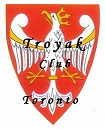
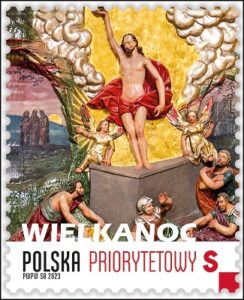
HAPPY EASTER !
WESOŁYCH ŚWIĄT WIELKANOCNYCH !
JOYEUSES PÂQUES !
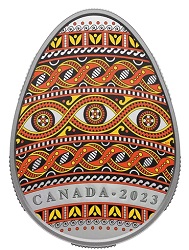

TROYAK EXECUTIVE TEAM is informing all members, colleagues, collectors, and Polonia at large, that Club meetings taking place at John Paul II Polish Cultural Centre, 4300 Cawthra Rd. (just south of Hwy. 403), Mississauga, Ontario. The new members are always welcome. www.polishculturalcentre.ca
ADRES SPOTKAÑ KLUBOWYCH ! Zarząd Główny Klubu “Troyak” informuje wszystkich członków kolekcjonerów, sympatyków oraz całą Polonię, że spotkania klubowe odbywają się w Polskim Centrum Kultury im. Jana Pawła II, przy 4300 Cawthra Rd. (na południe od autostrady 403), Mississauga, Ontario. Zapraszamy nowych członków do prężnego. Klubu “Troyak”. www.polishculturalcentre.ca

“TROYAK” CLUB NEXT MEETINGS …
NASTĘPNE SPOTKANIA KLUBU “TROYAK” …
Sunday 30th April 2023 @ 4:30 p.m.
28th May 2023; 25th June 2023
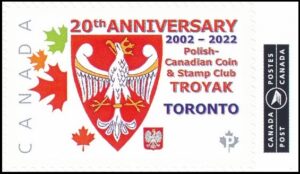
July & August 2023 – Summer break … Letnie wakacje …

TROYAK CLUB @ Roncesvalles Polish Festival 2023
Saturday, September 16th & Sunday, September 17th, 2023
https://polishfestival.ca www.kazimierz.org
St. Casimir’s Church
Parish Hall … 156 Roncesvalles Ave. Toronto, Ontario
Stamp Exhibit … Pope John Paul II on World Stamps and
Displays of Coins, Stamps, Collectibles by Troyak Club Members.
Roncesvalles Polish Festival
www.troyakclub.com
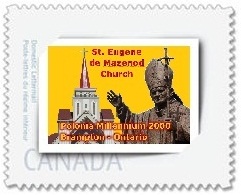
30th September 2023
29th October 2023
26th November 2023

Sunday – 3rd December 2023 @ 9:00 a.m. to 4:00 p.m.
Mississauga Coin & Stamp Show
December 2023 … Happy Holidays!


550. rocznica urodzin Mikołaja Kopernika
www.poczta-polska.pl
W dniu 16 lutym 2023 r. Poczta Polska wprowadziła do sprzedaży kopertę z nadrukowanym znakiem opłaty pocztowej, emisji: “550. rocznica urodzin Mikołaja Kopernika”. Wartość nominalna znaku opłaty pocztowej z oznaczeniem literowym A odpowiada wartości nominalnej znaczka pocztowego używanego do uiszczenia opłaty za ekonomiczną przesyłkę listową nierejestrowaną, w tym kartkę pocztową, w obrocie krajowym, w formacie S o masie do 500 g. Inspiracją dla powstania waloru filatelistycznego stał się Dom Mikołaja Kopernika w Toruniu, który w 2022 roku zdobył wyróżnienie specjalne podczas European Museum of the Year Award.
W części ilustracyjnej koperty przedstawiono fragment Domu Mikołaja Kopernika w Toruniu. To zabytkowa, gotycka kamienica, która w drugiej połowie XV wieku należała do rodziny Koperników. Obecnie, Dom Mikołaja Kopernika, stanowiący oddział Muzeum Okręgowego w Toruniu, przeszedł gruntowną modernizację w ramach projektu „Toruńska Starówka – ochrona i konserwacja dziedzictwa kulturowego UNESCO – etap II”. Pomieszczenia wyposażono nowoczesne technologie multimedialne, przy zachowaniu zabytkowego charakteru obiektu. W środkowej, górnej części koperty umieszczono nazwę emisji ,,550. rocznica urodzin Mikołaja Kopernika”.
W prawym górnym rogu strony adresowej koperty nadrukowano znak opłaty pocztowej, na którym znajduje się portret Mikołaja Kopernika autorstwa Teodora de Bry. W prawym dolnym rogu umieszczono oznaczenie wartości: A, a wzdłuż dolnej krawędzi napis: POLSKA. W projekcie datownika zawarto podpis Mikołaja Kopernika. Koperta została zaprojektowana we współpracy z Domem Mikołaja Kopernika, będącym oddziałem Muzeum Okręgowego w Toruniu. Kopertę o wymiarach 162 x 114 mm wydrukowano techniką offsetową, w nakładzie 5 000 sztuk. Autor: Jarosław Ochendzan.

Prezentacja koperty emisji „550. rocznica urodzin Mikołaja Kopernika” … Jubileuszowa prezentacja koperty z nadrukowanym znakiem opłaty pocztowej odbyła się w czasie uroczystej sesji Rady Miasta Torunia, inaugurującej obchody 550. rocznicy urodzin Mikołaja.
– Mikołaj Kopernik to jeden z najbardziej znanych Polaków na świecie. Jego odkrycia śmiało można nazwać przełomowymi dla ludzkości. Nie powinno zatem dziwić, że Poczta Polska, upamiętniająca ważne dla naszego kraju postaci czy wydarzenia, nie zapomniała o równej rocznicy urodzin naszego wybitnego astronoma i kanonika. Dzięki owocnej współpracy z Muzeum Okręgowym w Toruniu mamy możliwość pełniejszego uhonorowania dzieła Mikołaja Kopernika – podkreślił Wiesław Włodek, wiceprezes Poczty Polskiej.
O projekcie koperty z nadrukowanym znakiem opłaty pocztowej … Na kopercie został przedstawiony fragment domu Mikołaja Kopernika w Toruniu. To zabytkowa gotycka kamienica, która w drugiej połowie XV wieku należała do rodziny astronoma. Na znaku opłaty pocztowej znajduje się portret Kopernika autorstwa Teodora de Bry. W projekcie datownika zawarto podpis naszego wielkiego rodaka.
Współczesna historia emisji poświęconych Mikołajowi Kopernikowi … Ostatni raz kopertę z nadrukowanym znakiem opłaty pocztowej Poczta Polska wyemitowała 20 lat temu. Tegoroczne trzy emisje, poświęcone Mikołajowi Kopernikowi, to symboliczny wyraz uznania i podziękowania za odkrycia, które stały się podwaliną współczesnej astronomii. W styczniu Poczta Polska wydała znaczek pocztowy, przedstawiający portret astronoma, pochodzący z epitafium znajdującego się we fromborskiej Bazylice Archikatedralnej Wniebowzięcia Najświętszej Maryi Panny. Już wkrótce Poczta Polska wprowadzi jeszcze jeden walor filatelistyczny, przygotowany we współpracy z Pocztą Watykańską.

100-lecie Polskiego Towarzystwa Astronomicznego
www.poczta-polska.pl
W dniu 20 lutym 2023 r. została wprowadzona do obiegu kartka pocztowa z nadrukowanym znakiem opłaty pocztowej, emisji: “100-lecie Polskiego Towarzystwa Astronomicznego”. Wartość nominalna znaku opłaty pocztowej z oznaczeniem literowym A odpowiada wartości nominalnej znaczka pocztowego używanego do uiszczenia opłaty za ekonomiczną przesyłkę listową nierejestrowaną, w tym kartkę pocztową, w obrocie krajowym, w formacie S o masie do 500 g. Na znaku opłaty z oznaczeniem wartości A (3,90 zł) umieszczono logotyp Polskiego Towarzystwa Astronomicznego.

W części ilustracyjnej kartki przedstawiono fotografię galaktyki w kompozycji z obrazem nieba wykonanej przez Kosmiczny Teleskop Hubblea. W centralnej, dolnej części kartki umieszczono nazwę emisji ,,100 – lecie Polskiego Towarzystwa Astronomicznego”. Na datowniku umieszczono wizerunek Mikołaja Kopernika. Kartkę o wymiarach 148 x 105 mm wydrukowano jednostronnie, techniką offsetową, na kartonie białym, w nakładzie 5 000 sztuk. Autor: Roch Stefaniak.

550. rocznica urodzin Mikołaja Kopernika
www.poczta-polska.pl
Wspólna emisja filatelistyczna Poczty Polskiej i Poczty Watykańskiej, upamiętniająca Mikołaja Kopernika, została uroczyście zaprezentowana w Nuncjaturze Apostolskiej w Warszawie. To trzecie, tegoroczne już wydawnictwo Poczty Polskiej, które upamiętnia 550. rocznicę urodzin naszego wybitnego rodaka. Znaczek został zaprezentowany przez Salvatore Pennacchia, nuncjusza apostolskiego w Polsce oraz przedstawicieli zarządu Poczty Polskiej: prezesa Krzysztofa Falkowskiego oraz Wiesława Włodka, wiceprezesa odpowiedzialnego za działalność filatelistyczną.
– Poczta Polska jest instytucją, która aktywnie włączyła się w obchody Roku Mikołaja Kopernika. Wydaliśmy dwa znaczki i specjalną kopertę. 550. rocznica urodzin jednego z najbardziej znanych Polaków na świecie zasługuje na upamiętnienie godne wielkiego dzieła, które zrewolucjonizowało postrzeganie świata. Uhonorowanie Mikołaja Kopernika we współpracy z Pocztą Watykanu unaocznia, jak ważne miejsce wśród wybitnych światowych naukowców zajmuje nasz astronom i kanonik – powiedział Krzysztof Falkowski, prezes Poczty Polskiej.

W dniu 27 lutego 2023 roku został wprowadzony do obiegu znaczek pocztowy o wartości 8,00 zł emisji wspólnej Polski i Watykanu “550. rocznica urodzin Mikołaja Kopernika”. Na znaczku przedstawiono obraz Jana Matejki z 1873 roku z postacią Mikołaja Kopernika na tle katedry we Fromborku, lewym górnym rogu znaczka umieszczono napis POLSKA i oznaczenie wartości 8,00 zł. Znaczek wydrukowano techniką offsetową, na papierze fluorescencyjnym, w formacie 51 x 79 mm, w nakładzie 120 000 sztuk. Z tej okazji została wydana koperta FDC. Autorką projektu graficznego koperty FDC i datownika jest Pani Joanna Fleszar-Haspert.
Do projektu graficznego waloru filatelistycznego wykorzystano dzieło Jana Matejki pt. „Astronom Mikołaj Kopernik, czyli rozmowa z Bogiem”, pochodzące z 1873 roku i znajdujące się w zbiorach Muzeum Uniwersytetu Jagiellońskiego. To słynny obraz, który powstał z okazji 400. rocznicy urodzin astronoma. Dzieło przedstawia naszego wielkiego rodaka w trakcie obserwacji nieba z jego prywatnej wieży, znajdującej się u fromborskiego wzgórza katedralnego. Tym specjalnym walorem filatelistycznym Poczta Polska postanowiła docenić również innego patrona 2023 roku, autora obrazu, wybitnego Jana Matejkę. Malarz znany był ze swojego podziwu dla dokonań wielkiego astronoma, co znalazło wyraz także w spuściźnie artystycznej.
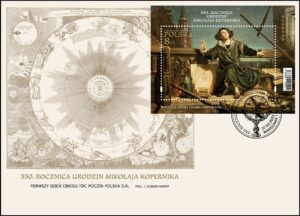
Tegoroczne walory filatelistyczne emisji poświęconej astronomowi … W styczniu 2023r. Poczta Polska wydała znaczek pocztowy wraz z kopertą pierwszego dnia obiegu (FDC), przedstawiający portret astronoma, pochodzący z epitafium znajdującego się we fromborskiej Bazylice Archikatedralnej Wniebowzięcia Najświętszej Maryi Panny. Obraz posiada wielką wartość artystyczną, ponieważ jest jedynym zachowanym wizerunkiem Mikołaja Kopernika we Fromborku – mieście najbardziej twórczego okresu polskiego odkrywcy i ostatnich lat jego życia.
W lutym Poczta Polska wprowadziła do sprzedaży kopertę z nadrukowanym znakiem opłaty pocztowej, której inspiracją stał się Dom Mikołaja Kopernika w Toruniu. W 2022 roku obiekt zdobył wyróżnienie specjalne podczas gali rozdania nagród European Museum of the Year Award. Co ciekawe, po raz ostatni kopertę z nadrukowanym znakiem opłaty pocztowej Poczta Polska wyemitowała 20 lat temu

Ptaki polskich parków
www.poczta-polska.pl
28 lutego, 2023 r. w Miejskim Ogrodzie Zoologicznym w Warszawie, odbyła się premiera czterech znaczków pocztowych emisji „Ptaki polskich parków”. Nowe wydawnictwa prezentują gatunki ptaków, które można zobaczyć w polskich parkach krajobrazowych, narodowych czy miejskich. Barwne wizerunki szpaka, grubodzioba, rudzika i trznadla znalazły się na tegorocznych projektach znaczków pocztowych. Zdjęcia bohaterów przyrodniczej emisji wykonał Maciej Zdziarski – dziennikarz, fotograf i pasjonat ptaków. Ptaki zostały uchwycone przez obiektyw w krakowskich parkach miejskich.
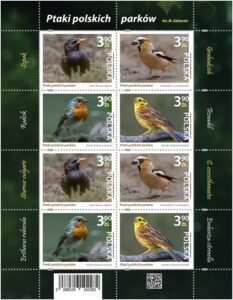
W dniu 28 lutego 2023 r. zostały wprowadzone do obiegu cztery znaczki pocztowe o wartości 3,90 zł każdy, emisji “Ptaki polskich parków”. Znaczki wydrukowano techniką offsetową, na papierze fluorescencyjnym, w formacie znaczka 51 x 39,50 mm, w nakładzie 112.000 sztuk każdego. Arkusz zawiera 8 znaczków (4×2). Na znaczkach przedstawiono ptaki występujące w polskich parkach – szpaka, grubodzioba, rudzika i trznadla. Emisji towarzyszą dwie koperty FDC (z grubodziobem i trznadlem). W grafice datownika jest fragment gałązki. Jest to druga odsłona emisji “Ptaki polskich parków”, pierwsza miała miejsce w roku 2022. Z tej okazji zostały wydane 2 koperty FDC. Autorem wszystkich zdjęć użytych na znaczkach jest Pan Maciej Zdziarski. Konsultacje merytoryczne zostały przeprowadzone z Panem dr. Andrzejem Kruszewiczem.
Charakterystyczne głosy ptaków tegorocznej emisji … Szpaki w swoich śpiewach zawierają nie tylko zasłyszane melodie innych ptaków, lecz także potrafią naśladować odgłosy, np. dzwonków telefonów komórkowych, gwizd czajnika, szczekanie psów, a nawet ludzkie rozmowy. Głos rudzika jest perlisty i porównuje się go do odgłosu pereł rozsypywanych na szkle. Melodia przedstawicieli płci męskiej jest mało słyszalna. Za najgłośniejsze uważane są osobniki młode. Śpiew Trznadla składa się z kilku krótkich, szybko następujących po sobie dźwięków i jednym długim. Jego głos zainspirował Ludwiga van Beethovena do napisania słynnej V Symfonii. Dźwięk grubodzioba to cykanie, mogące przypominać głos rudzika i trznadla. Swój śpiew urozmaica czasami gwizdami i kończy ją bardziej melodyjnymi tonami.
Poczta Polska promuje polską faunę … W 2022 roku Poczta Polska wprowadziła do obiegu pierwsze znaczki emisji „Ptaki polskich parków”, przedstawiające kowalika, wróbla, bogatkę i modraszkę. W tym samym roku Spółka wydała również znaczki we wspólnej emisji z Pocztą Argentyny. Przedstawiono na nich ptaki występujące jedynie w dwóch regionach – polską Czubatkę w Europie oraz argentyńskiego Garncarza Rdzawego w Ameryce Południowej.
Pierwsze dwa wydania emisji „Polskie ptaki” objęły znaczki w formie bloków, przedstawiające Zimorodka Zwyczajnego w 2014 r., a w 2019 r. Bociana Białego, Czarnego, Czaplę Białą oraz Siwą. W 2015 i 2017 roku do obiegu trafiły znaczki z ośmioma gatunkami rodzimych sów, m.in. Puchacza, Płomykówki, Puszczyka Mszarnego czy Uszatki. W 2019 roku wszedł do obiegu znaczek emisji „Europa” prezentujący Ziębę Zwyczajną. W tym samym roku ukazały się również znaczki, które powstały we współpracy z Pocztą Singapurską. Na znaczkach przedstawiono ptaki występujące w obu krajach: dzioborożca białobrzuchego, sokoła wędrownego. Konsultantem merytorycznym emisji „Ptaki polskich parków” jest dr Andrzej Kruszewicz.

Narodowy Dzień Pamięci Żołnierzy Wyklętych
www.poczta-polska.pl
W dniu 01 marca 2023 r. został wprowadzony do obiegu znaczek pocztowy o wartości 3,90 zł emisji “Narodowy Dzień Pamięci Żołnierzy Wyklętych”. Znaczek wydrukowano techniką rotograwiurową , na papierze fluorescencyjnym, w formacie znaczka 31,25 x 51 mm, w nakładzie 120.000 sztuk. Arkusz zawiera 12 znaczków. W tegorocznej emisji upamiętniamy postać abp Antoniego Baraniaka ( 1904- 1977).
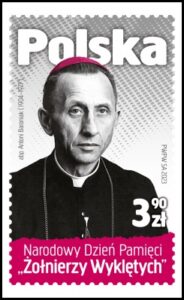
Biskup, selezjanin, kapelan i sekretarz prymasów Polski Augusta Hlonda oraz Stefana Wyszyńskiego, biskup pomocniczy gnieźnieński w latach 1957-1977. Aresztowany w nocy z 25 na 26 września 1953 r. równolegle z prymasem Wyszyńskim i oskarżony m.in. o kontakty z Zrzeszeniem Wolność i Niezawisłość. Był więziony na Rakowieckiej, brutalnie przesłuchiwany i torturowany. Nie ugiął się i dzisiaj jest nazywany Niezłomnym Żołnierzem Kościoła. Znaczek: wizerunek abp Antoniego Baraniaka. Koperta FDC: ściana celi na Rakowieckie, płaszcz abp Baraniaka, zdjęcia z wystawy w Muzeum Żołnierzy Wyklętych ” Baraniak 145 przesłuchań na Rakowieckiej”. Datownik: faksymile arcybiskupa. Wnioskodawcą jest Pani Poseł Ewa Kozanecka. Autor projektu znaczka: Jarosław Ochendzan.

Emil Korytko 1813-1839
www.poczta-polska.pl
W dniu 6 marca 2023 roku został wprowadzony do obiegu znaczek pocztowy o wartości 3,90 zł każdy, emisji “Emil Korytko (1813-1839)”. Emil Antoni Korytko herbu Jelita (ur. 7 września 1813 we Lwowie, zm. 31 stycznia 1839 w Lublanie) – polski etnograf, powstaniec, działacz niepodległościowy. Urodził się w rodzinie szlacheckiej jako syn Józefa Stanisława i Rudolfiny z Rubczyńskich. Studiował filozofię we Lwowie. Był uczestnikiem powstania listopadowego. Na podstawie donosu został zatrzymany w 1837 roku we Lwowie. Pomimo szczegółowego dochodzenia nie znaleziono dowodów obciążających. Za działalność konspiracyjną został zesłany na przymusowy pobyt w Lublanie.
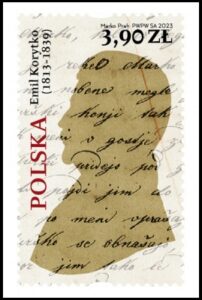
Na znaczku przedstawiono profil Emila Korytki na tle rękopisu jego wiersza. Na kopercie przedstawione jest zdjęcie nagrobka i napisu na pomniku. Na datowniku jest faksymile Emila Korytki. Emisja “Emil Korytko (1813-1839)” jest to wspólne wydanie Poczty Polskiej S.A. oraz Poczty Słowenii. Projekty znaczka, koperty FDC i datownika zostały wykonane przez słoweńskiego grafika Marko Prah. Konsultacje przy emisji zostały prowadzone z Pocztą Słowenii. Znaczek wydrukowano techniką offsetową, na papierze fluorescencyjnym, w formacie 31,25 x 51 mm, w nakładzie 128 000 sztuk. Arkusz sprzedażny zawiera 8 sztuk znaczków. Z tej okazji została wydana koperta FDC. Autor projektu: Marko Prah.

Wielkanoc
Easter
www.poczta-polska.pl
W dniu 20 marca 2023 roku został wprowadzony do obiegu znaczek pocztowy o wartości 4,80 zł emisji “Wielkanoc”. Na znaczku umieszczono zdjęcie jednej z kwater siedemnastowiecznego ołtarza, przedstawiającej Zmartwychwstanie, znajdującego się w kościele pw. św. Jerzego w Dzierżoniowie. Wzdłuż dolnej krawędzi umieszczono napisy: Wielkanoc, POLSKA i oznaczenie: PRIORYTETOWY S, co odpowiada wartości nominalnej znaczka pocztowego właściwego do uiszczania opłaty za przesyłkę listową nierejestrowaną priorytetową w obrocie krajowym w formacie S i priorytetową kartkę pocztową w obrocie krajowym. Znaczki wydrukowano techniką rotograwiurową, na papierze fluorescencyjnym, w formacie 25,5 x 31,25 mm, w nakładzie wielomilionowym, powtarzalnym. Arkusz sprzedażny zawiera 100 sztuk znaczków. Z tej okazji została wydana koperta FDC.

Do stworzenia tegorocznej emisji wykorzystano fotografię fragmentu kwatery siedemnastowiecznego ołtarza głównego, mieszczącego się w kościele pw. św. Jerzego w Dzierżoniowie. Barwna płaskorzeźba prezentuje scenę Zmartwychwstania Jezusa Chrystusa. Uzupełnieniem nowego znaczka jest limitowana wersja koperty FDC Pierwszego Dnia Obiegu, zaprojektowana przez Jarosława Ochendzana. W tle koperty przedstawiono zdjęcie pisanek barwionych metodą kraszenia. Wraz z wielkanocną emisją filatelistyczną pojawił się również okolicznościowy datownik, w którego grafice przedstawiono Baranka Bożego symbolizującego ofiarę Jezusa Chrystusa złożoną na krzyżu.
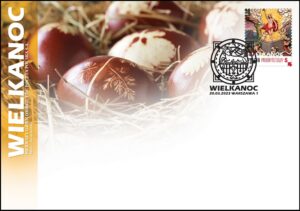
Zabytkowy kościół w projekcie wielkanocnego znaczka … Kościół pw. św. Jerzego jest najstarszym sakralnym zabytkiem Dzierżoniowa, nierozerwalnie związanym z historią miasta. Według miejskich legend kościół został wybudowany 1159 roku z polecenia księcia Bolesława Kędzierzawego. Pierwsza pewna wzmianka źródłowa o świątyni pochodzi z 1258 roku. Wystrój kościoła prezentuje styl manieryzmu, baroku i klasycyzmu. W 1719 roku przystąpiono do budowy nowego ołtarza głównego. W ten sposób ołtarz z cyklem chrystologicznym został uzupełniony o nastawę o tematyce maryjnej. Przed ołtarzem Zbawiciela ustawiono więc ołtarz Matki Boskiej ze skrzydłami bocznymi.
Wielkanocne walory filatelistyczne Poczty Polskiej … Od lat Poczta Polska prezentowała na wielkanocnych znaczkach pocztowych polski folklor, ukazujący piękno polskiej sztuki ludowej. Na walorach wykorzystano m.in. pisanki opoczyńskie, kozienickie, opolskie, kurpiowskie, huculskie, łemkowskie, lubelskie i lipskie. W 2019 roku Spółka wyemitowała również znaczki pocztowe podkreślające wyjątkowość kaszubskiej obrzędowości wielkanocnej. W 2021 roku wydano znaczek pocztowy z grafiką prezentującą pisankę podhalańską, która kończyła cały cykl poświęcony regionalnym technikom zdobienia wielkanocnych jaj. W 2022 roku w projekcie znaczka pojawił się fragment fresku „Chwała Zmartwychwstałego Jezusa”, pochodzącego z kopuły kaplicy bocznej Najświętszego Sakramentu katedry w Rawennie we Włoszech.

Skarby Stanisława Augusta – Stanisław Leszczyński
www.nbp.pl
Skarby Stanisława Augusta Wyjątkowa seria złotych i srebrnych monet kolekcjonerskich o nominałach 500 zł i 50 zł – „Skarby Stanisława Augusta” – odwzorowuje słynną osiemnastowieczną serię medalierską z wizerunkami królów Polski wykonaną na zlecenie Stanisława Augusta Poniatowskiego. Królewskie medale powstawały w mennicy warszawskiej w latach 1791–1797/1798. Ich twórcami byli dwaj wybitni medalierzy Jan Filip Holzhaeusser i Jan Jakub Reichel. Medale były wzorowane na portretach namalowanych w latach 1768–1771 przez Marcella Bacciarellego do Pokoju Marmurowego w Zamku Królewskim w Warszawie. Monety emitowane przez Narodowy Bank Polski są wiernymi replikami medali, zachowują średnicę i wysokość reliefu oryginałów. Dotyczy to portretów królewskich prezentowanych na rewersach monet. Odwrotne strony medali z życiorysami królów, umieszczone na awersach monet, zostały pomniejszone, ponieważ towarzyszy im otok z nazwą państwa, godłem Rzeczypospolitej, nominałem oraz rokiem emisji.
Życiorysy monarchów, jak również napisy na awersach medali towarzyszące portretom władców, zredagowane są po łacinie. Ostatecznej redakcji tych tekstów dokonał zapewne sam król Stanisław August. Imiona monarchów w języku polskim umieszczone zostały na boku monet; tamże znajduje się nazwa serii „Skarby Stanisława Augusta”. Poczet królów polskich wykonany na zlecenie Stanisława Augusta Poniatowskiego składał się z wizerunków 23 monarchów. Był tu o jeden portret królewski więcej niż na obrazach Bacciarellego, którego cykl obejmuje 22 obrazy. Dodatkowy portret Stanisława Leszczyńskiego, umieszczony na medalu, powstał najprawdopodobniej na podstawie obrazu Jana Bogumiła Plerscha.
Obie serie, malarska i medalierska, zaczynają się od Bolesława Chrobrego, a kończą wizerunkiem Augusta III Sasa. W Pokoju Marmurowym od XVIII wieku naczelne miejsce zajmuje jednak kilkakrotnie większy od pozostałych królewskich portretów wizerunek Stanisława Augusta w pełnej postaci, w stroju koronacyjnym. Zapewne więc i serię medalierską zamykać miał medal z wizerunkiem aktualnie panującego monarchy. Abdykacja, emigracja i rychła śmierć króla w początku 1798 r. uniemożliwiły realizację tego zamierzenia. Seria monet „Skarby Stanisława Augusta” obejmuje 24 wizerunki monarchów – 23 z oryginalnej serii królewskiej oraz portret Stanisława Augusta, odtworzony według medali z epoki. Tak jak w XVIII wieku medale, monety będą bite w złocie i w srebrze. Informacja: Tomasz Bylicki, starszy kustosz Muzeum Historyczne m.st. Warszawy.
Nominał: 500 zł … metal: Au 999,9/1000; stempel: zwykły; średnica: 45 mm; masa: 62,2 g; napis na obrzeżu: SKARBY STANISŁAWA AUGUSTA * STANISŁAW LESZCZYŃSKI *; nakład: do 600 szt.; Projektant rewersu – Anna Wątróbska-Wdowiarska; Projektant awersu oraz napisów na rewersie – Robert Kotowicz; Na zlecenie NBP monetę wyprodukowała Mennica Polska S.A.; Emisja: 26 stycznia 2023 r.
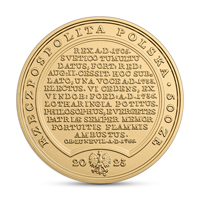
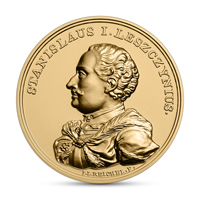
Król, wyniesiony na tron podczas szwedzkich zamieszek w Roku Pańskim 1705, ustąpił sile powracającego Augusta II. Po śmierci tegoż jednogłośnie wybrany Roku Pańskiego 1733. Ustępując przed przemocą, na podstawie traktatu wiedeńskiego Roku Pańskiego 1736 objął we władanie Lotaryngię. Filozof, dobroczyńca, pomny zawsze na ojczyznę, przypadkowymi płomieniami poparzony, umarł w Lunéville Roku Pańskiego 1766, w dniu 23 lutego, mając lat 89.
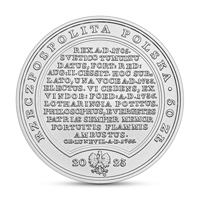

Nominał: 50 zł … metal: Ag 999/1000; stempel: zwykły; średnica: 45 mm; masa: 62,2 g; napis na obrzeżu: SKARBY STANISŁAWA AUGUSTA * STANISŁAW LESZCZYŃSKI *; nakład: do 6000 szt.; Projektant rewersu – Anna Wątróbska-Wdowiarska; Projektant awersu oraz napisów na rewersie – Robert Kotowicz; Na zlecenie NBP monetę wyprodukowała Mennica Polska S.A.; Emisja: 26 stycznia 2023 r.
Stanisław Leszczyński (1704−1709, 1733–1736) Dwudziesta druga moneta serii przedstawia Stanisława I Leszczyńskiego (1677–1766), który dwukrotnie obejmował tron polski, a ostatnie 30 lat długiego życia spędził jako książę Lotaryngii i Baru. Po wybuchu wojny północnej, gdy August II zrzekł się korony polskiej, z woli szlachty polskiej i króla szwedzkiego 12 lipca 1704 r. Stanisław został obrany na króla i koronowany 4 października 1705 r. Po klęsce Szwedów pod Połtawą w 1709 r. został zmuszony do emigracji, a na tron polski powrócił August II. Po jego śmierci, w 1733 r. odbyła się w Warszawie podwójna elekcja; 12 września, podczas pierwszej z nich, na króla został obrany Stanisław z poparciem Francji, a 5 października August III Sas z poparciem Rosji. Wybuchła wojna sukcesyjna o tron polski, w którą były zaangażowane obce mocarstwa (co dosadnie ilustruje powiedzenie „Jedni do Sasa, drudzy do Lasa”). W jej wyniku w styczniu 1736 r. Stanisław złożył koronę i z łaski króla francuskiego Ludwika XV osiadł w Lotaryngii.
Na rewersie monety widnieje przeniesione z medalu popiersie króla (zapewne według obrazu Jana Bogumiła Plerscha) w lewym profilu, z krótkimi włosami zaczesanymi do tyłu, z wąsami, w kirysie i w płaszczu z futrzanym kołnierzem spiętym zaponą. Na awersie monety czytamy tekst z rewersu medalu (w tłumaczeniu): Król, wyniesiony na tron podczas szwedzkich zamieszek w Roku Pańskim 1705, ustąpił sile powracającego Augusta II. Po śmierci tegoż jednogłośnie wybrany Roku Pańskiego 1733. Ustępując przed przemocą, na podstawie traktatu wiedeńskiego Roku Pańskiego 1736 objął we władanie Lotaryngię. Filozof, dobroczyńca, pomny zawsze na ojczyznę, przypadkowymi płomieniami poparzony, umarł w Lunéville Roku Pańskiego 1766, w dniu 23 lutego, mając lat 89. Stanisław Leszczyński herbu Wieniawa był synem podskarbiego Rafała Leszczyńskiego i Anny z Jabłonowskich. Odebrał staranne wykształcenie domowe i w gimnazjum protestanckim w Lesznie.
W 1698 r. pojął za żonę Katarzynę Opalińską. August II mianował go w 1699 r. wojewodą poznańskim. Po wkroczeniu wojsk szwedzkich do Polski Stanisław Leszczyński przystąpił do antykrólewskiej konfederacji warszawskiej. Zawiązał sojusz z królem szwedzkim Karolem XII, który wysunął go na kandydata do tronu polskiego, widząc jego wpływy w Wielkopolsce. Po abdykacji Augusta II obrano na króla polskiego Stanisława Leszczyńskiego. Panował pięć bez mała lat, w czasie których trwała w Polsce wojna ze Szwedami. Po ponownym objęciu władzy przez Augusta II Stanisław z rodziną wiódł życie tułacze, podejmując nieskuteczne próby powrotu na tron.
W latach 1714–1719 Szwedzi uczynili go panem Księstwa Dwóch Mostów (Zweibrücken), a następne lata, do 1733 r., spędził w Wissembourgu w Alzacji. W 1725 r. w Fontainebleau odbyło się wesele – król francuski Ludwik XV ożenił się z młodszą córką Stanisława Marią. Dzięki protekcji zięcia Leszczyński w 1733 r. ponownie włożył polską koronę i ponownie, mimo wojny zbrojnej, nie zdołał jej utrzymać. Wrócił do Francji, gdzie otrzymał w dożywocie Księstwo Lotaryngii i Baru. Przez 30 lat panowania zyskał tam uznanie jako dobry gospodarz, mecenas sztuki i nauki. Nosił najwyższe francuskie odznaczenie – Order Ducha Świętego. Założył uczelnie w Lunéville i Nancy (gdzie stoi jego pomnik), przyjmował u siebie encyklopedystów, m.in. Woltera i Monteskiusza, ufundował szpital dla ubogich, tam napisał wydane anonimowo postępowe dzieło Głos wolny wolność ubezpieczający. Nieszczęśliwe zdarzenie zakończyło życie Stanisława Leszczyńskiego. Rewolucja zniszczyła jego nagrobek w Nancy; szczątki przywieziono do kraju, gdzie ostatecznie w 1938 r. złożono je w katedrze wawelskiej, w krypcie Zygmuntowskiej. Informacja: Marta Męclewska.
Emisja wartości kolekcjonerskich stanowi okazję do upamiętnienia ważnych historycznych rocznic i postaci oraz do rozwijania zainteresowań polską kulturą, nauką i tradycją. Narodowy Bank Polski jest centralnym bankiem państwa odpowiadającym za politykę pieniężną i stabilność cen. Jego funkcje określa Konstytucja Rzeczypospolitej Polskiej i Ustawa o NBP. NBP ma wyłączne prawo emisji pieniądza. Jako bank centralny nie prowadzi rachunków bankowych obywateli, nie przyjmuje od nich lokat ani nie udziela kredytów. Prowadzi natomiast obsługę budżetu państwa, a także podmiotów sektora finansów publicznych. Gromadzi rezerwy walutowe państwa i zarządza nimi. Pełni funkcję banku banków, tworząc warunki do działania systemu bankowego. Jest również jednym z najważniejszych ośrodków naukowo-analitycznych w dziedzinie ekonomii i rynków finansowych.

Treasures of Stanislaw August – Stanisław Leszczyński
www.nbp.pl
Treasures of Stanisław August … The unique series of gold and silver collector coins with the face values of 500 zloty and 50 zloty – “TREASURES OF STANISŁAW AUGUST” – replicates the famous 18th century medallic series with the images of the kings of Poland, which was struck on the order of Stanisław August Poniatowski. The royal medals, designed by two outstanding medallists: Jan Filip Holzhaeusser and Jan Jakub Reichel, were struck at the Warsaw mint in the years 1791–1797/1798. The design of the medals was based on portraits painted between 1768 and 1771 by Marcello Bacciarelli for the Marble Room at the Royal Castle in Warsaw. The coins issued by Narodowy Bank Polski are faithful replicas of the medals, preserving the diameter and height of relief of the originals. This applies to the portraits of the kings on the reverses. The obverses of the coins feature the reverses of the medals with biographies of the monarchs.
The reverses of the medals have been reduced in size because they are accompanied by the name of the state along the rim, the image of the state emblem, the face value and the year of issue of the coins. The biographies of the monarchs and the inscriptions on the obverses of the medals accompanying the royal portraits are in Latin. The final text editing was most likely done by King Stanisław August himself. The names of the monarchs in Polish are presented on the sides of the coins, along with the name of the series “Treasures of Stanisław August”. The gallery of portraits of Polish kings, painted on the order of Stanisław August Poniatowski, consisted of images of 23 monarchs. It included one royal portrait more than Bacciarelli’s series of 22 paintings. The additional portrait of Stanisław Leszczyński – featured on the medal – was most probably modelled on a painting by Jan Bogumił Plersch. Both series, the paintings and the medals, begin with the image of Bolesław Chrobry and end with the portrait of August III.
Since the 18th century, the principal place in the Marble Room has belonged to the portrait of the full length figure of Stanisław August in his coronation robes. The painting is several times larger than other portraits. It is therefore probable that the medallic series would have finished with a medal presenting the image of the ruling monarch. However, these plans were thwarted by the king’s abdication, emigration and early death at the beginning of 1798. The series of coins “Treasures of Stanisław August” consists of 24 portraits of monarchs – of which 23 have been modelled on the royal series plus a portrait of Stanisław August based on the medals from the period. The series will be struck in silver and gold, as was the practice in the 18th century. Info: Tomasz Bylicki, senior curator Historical Museum of Warsaw.
Face value: 500 zł … metal: Au 999.9/1000; finish: standard; diameter: 45 mm; weight: 62.2 g; On the edge, the inscription: SKARBY STANISŁAWA AUGUSTA * STANISŁAW LESZCZYŃSKI *; mintage: up to 600 pcs; Designer: reverse – Anna Wątróbska-Wdowiarska; Obverse and inscriptions on the reverse – Robert Kotowicz; Producer: Mennica Polska S.A. commissioned by NBP; Date of issue: 26 January 2023.


The King, raised to the throne during the Swedish riots Anno Domini 1705, gave way to the power of the returning Augustus II. After the death of Augustus II, unanimously elected Anno Domini 1733. Giving in to violence, on the basis of the Treaty of Vienna Anno Domini 1736, he took possession of Lorraine. A philosopher, benefactor, always mindful of his homeland, burnt by accidental flames, he died in Lunéville on 23 February Anno Domini 1766, at the age of 89.


Face value: 50 zł … metal: Ag 999/1000; finish: standard; diameter: 45 mm; weight: 62.2 g; On the edge, the inscription: SKARBY STANISŁAWA AUGUSTA * STANISŁAW LESZCZYŃSKI *; mintage: up to 6,000 pcs; Designer: reverse – Anna Wątróbska-Wdowiarska; Obverse and inscriptions on the reverse – Robert Kotowicz; Producer: Mennica Polska S.A. commissioned by NBP; Date of issue: 26 January 2023.
Stanisław Leszczyński (1704-1709, 1733-1736) … The twenty second coin of the series depicts Stanisław Leszczyński (1677–1766), who twice ascended to the Polish throne, and spent the last 30 years of his long life as Duke of Lorraine and Bar. After the outbreak of the Great Northern War, when Augustus II the Strong renounced the Polish crown on 12 July 1704, Stanisław was elected king by the will of the Polish nobility and the Swedish king and crowned on 4 October 1705. After the defeat of the Swedes at Poltava in 1709, he was forced to emigrate and Augustus II the Strong returned to the Polish throne. After his death, in 1733, a double election was held in Warsaw. On 12 September, during the first of them, Stanisław was elected king with the support of France, and on 5 October Augustus III was elected king with the support of Russia. A succession war for the Polish throne broke out and the world powers got involved. As a result, Stanisław yielded the crown in January 1736 and, by the grace of the king of France, Louis XV, settled in Lorraine.
The reverse of the coin features a bust of the king, transferred from the medal (probably according to a painting by Jan Bogumił Plersch), with the profile facing left, with short hair pulled back, with a moustache, wearing a cuirass and a coat with a fur collar fastened with a clasp. On the obverse of the coin, the text from the reverse of the medal (in translation) reads: The King, raised to the throne during the Swedish riots Anno Domini 1705, gave way to the power of the returning Augustus II. After the death of Augustus II, unanimously elected Anno Domini 1733. Giving in to violence, on the basis of the Treaty of Vienna Anno Domini 1736, he took possession of Lorraine. A philosopher, benefactor, always mindful of his homeland, burnt by accidental flames, he died in Lunéville on 23 February Anno Domini 1766, at the age of 89. Stanisław Leszczyński of the Wieniawa coat of arms was the son of the treasurer Rafał Leszczyński and Anna née Jabłonowska. He received a thorough education at home and at the Protestant gymnasium in Leszno. In 1698, he married Katarzyna Opalińska. Augustus II the Strong appointed him the voivode of Poznań in 1699. After the Swedish army invaded Poland, Stanisław Leszczyński joined the anti-royal Warsaw confederation. He formed an alliance with the Swedish king, Charles XII, who, seeing his influence in Greater Poland, put him forward as a candidate for the Polish throne.
Following the abdication of Augustus II the Strong, Stanisław was elected King of Poland. He reigned for almost five years, during which the war with the Swedes continued in Poland. After Augustus II the Strong took power again, Stanisław and his family led a wandering life, making unsuccessful attempts to return to the throne. In the years 1714-1719, the Swedes appointed him lord of the Duchy of Two Bridges (Zweibrücken), and the following years, until 1733, he spent in Wissembourg in Alsace. In 1725, a wedding took place in Fontainebleau – king of France, Louis XV, married Maria, the younger daughter of Stanisław. Thanks to the patronage of his son-in-law, in 1733 Leszczyński put on the Polish crown again. Once again, despite the armed war, he failed to keep it. He returned to France, where he received the Duchy of Lorraine and Bar for life.
During the 30 years of his reign there, he gained recognition as a good ruler, patron of the arts and sciences. He wore the highest French decoration, the Order of the Holy Spirit. He founded universities in Lunéville and Nancy (where his statue stands), funded a hospital for the poor, hosted the Encyclopaedists, including Voltaire and Montesquieu, and there he wrote the progressive work Głos wolny wolność ubezpieczający [A Free Voice Ensuring Freedom], which was published anonymously. An unfortunate event ended Stanisław Leszczyński’s life. The French Revolution destroyed his tombstone in Nancy; his remains were brought to Poland, where, in 1938, they were finally deposited at Wawel Cathedral, in the Sigismund Crypt. Info: Marta Męclewska.
Issuing collector items is an occasion to commemorate important historic figures and anniversaries, as well as to develop interest of the public in Polish culture, science, and tradition. Narodowy Bank Polski is the central bank of the State, responsible for its monetary policy and price stability. The Bank’s functions are described in the Constitution of the Republic of Poland and the Act on NBP. NBP holds the exclusive right to issue the currency of the Republic of Poland. As the central bank, it does not provide accounts for the general public, accept deposits from or extend loans to individuals. It acts as a banker to the State budget and public sector entities. NBP also holds and manages the foreign exchange reserves of the State. Finally, it functions as a banker to banks, creating conditions for the operation of the Polish banking system. Narodowy Bank Polski is one of the most important research and analytical centres in the fields of economics and financial markets.

Mikołaj Kopernik
www.nbp.pl
Narodowy Bank Polski jest centralnym bankiem państwa odpowiadającym za politykę pieniężną i stabilność cen. Jego funkcje określa Konstytucja Rzeczypospolitej Polskiej i ustawa o NBP. NBP ma wyłączne prawo emisji pieniądza. Jako bank centralny nie prowadzi rachunków bankowych obywateli, nie przyjmuje od nich lokat, nie udziela kredytów. Prowadzi natomiast obsługę budżetu państwa, a także podmiotów sektora finansów publicznych. Gromadzi rezerwy walutowe państwa i zarządza nimi. Pełni funkcję banku banków, tworząc warunki do działania systemu bankowego. Jest również jednym z najważniejszych ośrodków naukowo-analitycznych w dziedzinie ekonomii i rynków finansowych.
Emisja wartości kolekcjonerskich stanowi okazję do upamiętniania ważnych historycznych rocznic i postaci oraz do rozwijania zainteresowań polską kulturą, nauką i tradycją. 9 lutego 2023 roku Narodowy Bank Polski wprowadził do obiegu srebrną monetę o nominale 50 zł „Mikołaj Kopernik”.


Nominał 50 zł … metal: Ag 999/1000; stempel: zwykły, wysoki relief, bursztyn; średnica: 45,00 mm; masa: 62,20 g; brzeg (bok): gładki; nakład: do 7000 szt.; Projektant: Urszula Walerzak; Emitent: NBP; Na zlecenie NBP monety wyprodukowała Mennica Polska S.A.
Rewers monety przedstawia fragment pomnika Mikołaja Kopernika w Warszawie oraz stylizowany wizerunek promieni słonecznych. Na awersie poza stałymi elementami, takimi jak wizerunek orła ustalony dla godła Rzeczypospolitej Polskiej, nominał oraz oznaczenie roku emisji, został umieszczony wizerunek Układu Słonecznego z dzieła Mikołaja Kopernika De revolutionibus orbium coelestium.
W 2023 r. przypadają obchody 550-lecia urodzin Mikołaja Kopernika, wybitnego astronoma, twórcy teorii heliocentrycznej, lekarza, ekonomisty – autora jednej z wersji prawa rządzącego obiegiem pieniądza (gorszy pieniądz zawsze wypiera lepszy), wiernego poddanego polskich królów – obrońcy Olsztyna przed Krzyżakami. Mikołaj Kopernik urodził się w Toruniu 19 lutego 1473 r. w rodzinie bogatego kupca Mikołaja Kopernika i Barbary z domu Watzenrode. Jego ojciec pochodził ze Śląska, a matka z patrycjuszowskiej rodziny toruńskiej. Przyszły astronom uczył się najpierw w Toruniu, potem zapewne w Chełmnie. W latach 1491–1503 studiował w Krakowie, Bolonii i Padwie. Studia zakończył uzyskaniem doktoratu z prawa kanonicznego w Ferrarze w 1503 r. W 1503 r. Kopernik powrócił do Polski i osiadł na Warmii, gdzie biskupem był jego wuj i mecenas Łukasz Watzenrode. Już wcześniej, w 1495 r. astronom został kanonikiem warmińskim. W latach 1503–1510 mieszkał przy wuju w Lidzbarku Warmińskim, a od 1510 r. w zasadzie stale przebywał we Fromborku, jedynie w latach 1519–1521 w Olsztynie.
Najważniejszym dziełem Kopernika jest praca De revolutionibus orbium coelestium (O obrotach sfer niebieskich). Przypuszcza się, że Kopernik zaczął ją pisać w 1514 r., a skończył około 1530 r. Długo zwlekał z jej wydaniem – wyszła drukiem w 1543 r. dzięki staraniom niemieckiego uczonego Jerzego Joachima Retyka. Nie jest pewne, czy autor zobaczył swoje dzieło przed śmiercią w maju 1543 r. Informacja: Prof. dr hab. Krzysztof Mikulski.

Nicolaus Copernicus
www.nbp.pl
Narodowy Bank Polski is the central bank of the State, responsible for its monetary policy and price stability. The Bank’s functions are described in the Constitution of the Republic of Poland and the Act on NBP. NBP holds the exclusive right to issue the currency of the Republic of Poland. As the central bank, it does not provide accounts for the general public, accept deposits from or extend loans to individuals. It acts as a banker to the State budget and public sector entities. NBP also holds and manages the foreign exchange reserves of the State. Finally, it functions as a banker to banks, creating conditions for the operation of the Polish banking system. Narodowy Bank Polski is one of the most important research and analytical centres in the fields of economics and financial markets.
Issuing collector items is an occasion to commemorate important historic figures and anniversaries, as well as to develop the interest of the public in Polish culture, science and tradition. On 9 February 2023, Narodowy Bank Polski issued into circulation a silver coin “Nicolaus Copernicus”, with a face value of 50 złoty.


Face value: 50 zł … Metal: Ag 999/1000; Finish: standard, high relief, amber; Diameter: 45.00 mm; Weight: 62.20 g; Edge (side): plain; Mintage: up to 7,000 pcs; Designer: Urszula Walerzak; Issuer: NBP; The coins, commissioned by NBP, were struck by Mennica Polska S.A.
The reverse of the coin features a fragment of the monument to Nicolaus Copernicus in Warsaw and a stylised image of sunrays. The obverse features – in addition to the regular elements such as the image of the Eagle established as the state emblem of the Republic of Poland, the face value and the notation of the year of issue – an image of the Solar System from Nicolaus Copernicus’s work De revolutionibus orbium coelestium.
The year 2023 will mark the 550th Anniversary of the birth of Nicolaus Copernicus, outstanding astronomer, creator of the heliocentric theory, physician, economist – author of one of the versions of the law governing the circulation of money (bad money always drives out good money), and faithful subject of Polish kings – defender of Olsztyn against the Teutonic Knights. Nicolaus Copernicus was born in Toruń on 19 February 1473 to the family of a wealthy merchant Nicolaus Copernicus and Barbara née Watzenrode. His father came from Silesia and his mother from a patrician Toruń family. The future astronomer was first educated in Toruń, then probably in Chełmno. In 1491–1503, he studied in Kraków, Bologna and Padua. He completed his studies with a doctorate in canon law in Ferrara in 1503. In 1503 Copernicus returned to Poland and settled in Warmia, where his uncle and patron Łukasz Watzenrode was bishop. Before, in 1495, the astronomer had become a canon of Warmia. From 1503 to 1510, he lived with his uncle in Lidzbark Warmiński, and from 1510 onwards he basically stayed permanently in Frombork, and only in 1519-1521 in Olsztyn.
Copernicus’s most important work is De revolutionibus orbium coelestium [On the Revolutions of the Heavenly Spheres]. Copernicus is believed to have started writing it in 1514 and to have finished it around 1530. He delayed its publication for a long time – it was published in 1543 thanks to the eff orts of the German scholar Joachim Rheticus. It is uncertain whether the author saw his work before he died in May 1543. Info: Krzysztof Mikulski, PhD, DSc, Prof Tit.


Ranunculus: PermanentTM domestic rate stamps
www.canadapost.ca
This year’s flower stamp issue depicts Ranunculus asiaticus on 2 stamps. The annual flower issue is a bestseller, and often used to mail wedding stationery such as invitations. It’s also popular stamp among Canadian gardeners. The coil strip features 2 of each design. About the flower … Ranunculus asiaticus, also known as Persian buttercup, is native to southwestern Asia, southern Europe and northern Africa. The plant may have arrived in northern Europe during the Crusades but was not cultivated widely until the 17th century. The name Ranunculus comes from the Latin words for “little frog” because many species grow near streams. However, Ranunculus asiaticus is partial to sunny hillsides and pastures.

Known for radiant, rose-like blossoms, Ranunculus may be single or double flowered. It has gossamer-thin petals and grows in a palette of colours. Florists and gardeners love them, and they are a popular choice for wedding bouquets and centrepieces. Traditionally, offering these blooms is a way of saying, “I’m dazzled by your charms!”. Stamp Value: Permanent™ domestic rate; Stamp Designer: Stéphane Huot; Issue Date: March 1, 2023.
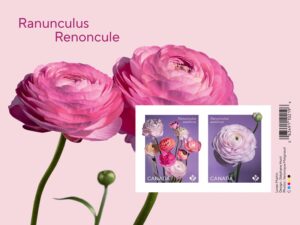
This year’s flower stamp issue souvenir sheet features Ranunculus asiaticus on 2 stamps. The annual flower issue is a bestseller, and often used to mail wedding stationery such as invitations. It’s also popular stamp among Canadian gardeners. Take home or gift this souvenir sheet. Stamp Value: Permanent™ domestic rate; Stamp Designer: Stéphane Huot; Quantity Produced: 60,000; Issue Date: March 1, 2023.

Ranunculus: Official First Day Cover … This year’s flower stamp issue depicts Ranunculus asiaticus on 2 stamps. The annual flower issue is a bestseller, and often used to mail wedding stationery such as invitations. It’s also popular stamp among Canadian gardeners. Take home or gift this Official First Day Cover (OFDC). The OFDC design features a beautiful pale pink Ranunculus and a cancel mark shaped like the flower in bloom. Goderich, ON was chosen for the cancel location because it was once said to be described as “the prettiest town in Canada” due in part to its charming historic character, as well as its award-winning flower gardens. Stamp Value: Permanent™ domestic rate; Stamp Designer: Stéphane Huot; Quantity Produced: 7,000; Issue Date: March 1, 2023.

2023 … Eid: PermanentTM domestic rate stamps
www.canadapost.ca
Eid Mubarak! Celebrate the Muslim festivals of Eid al-Fitr and Eid al-Adha with this booklet of 6 stamps. This stamp issue commemorates the festivals of Eid al-Fitr and Eid al-Adha, which are celebrated by more than one million Muslims in Canada. These events can last several days and include communal prayers and feasts, visits with family, gift giving and acts of charity.
About the stamp and booklet design … Crafted in medieval Iran during Ramadan, the hand-painted ceramic bowl on this year’s Eid stamp was likely used to serve dates, soups and other foods each night, to break the fast. Part of a collection held by the Royal Ontario Museum (ROM), it is inscribed on the inside with a Persian poem. The bowl has a special connection to the festival of Eid al-Fitr, which is also known as the Festival of Breaking the Fast. Written in calligraphy above the bowl are the words Eid Mubarak, a traditional Arabic greeting that means “have a blessed Eid.” The front of the booklet shows photos of the inside of the bowl. The inside of the booklet features a translation of one of the lines from the poem inscribed on the inside of the bowl, “May you enjoy whatever you eat from this bowl.”

About Eid and Ramadan … Muslims in Canada and around the world fast (abstain from eating and drinking) from dawn to sunset during Ramadan – one of the holiest months in the Islamic calendar. This ritual fasting is both an act of worship and a form of self-purification and spiritual growth. Eid al-Fitr, or the Festival of Breaking the Fast, marks the end of Ramadan, the month of fasting. Fasting, which is observed from sunrise to sunset, is one of the most distinctive practices in the Islamic religion.
Eid al-Adha, or the Festival of Sacrifice, marks the end of the Hajj pilgrimage, in which millions of Muslims journey to one of the holiest sites in Islam – the Kaaba in Mecca, Saudi Arabia. The festival also honours the prophet Abraham (Ibrahim), a revered figure within Judaism, Christianity and Islam, for his willingness to sacrifice his son as an act of obedience to God. Before Ibrahim could sacrifice Isma’il (known as Isaac in the Jewish and Christian traditions), God substituted a lamb. The festival is also called Eid al-Kabir, or the Greater of the two Eids. Both festivals embody central Islamic practices and values, including empathy and sacrifice for those in need and appreciation for one’s community and greater humanity. These are expressed through communal prayers and feasts, gift giving and acts of charity. Stamp Value: Permanent™ domestic rate; Stamp Designer: Subplot Design Inc.; Quantity Produced: 55,000; Issue Date April 3, 2023.
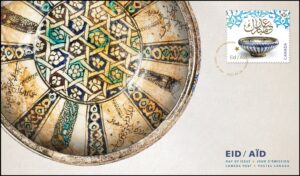
Eid … Official First Day Cover … Eid Mubarak! Celebrate the Muslim festivals of Eid al-Fitr and Eid al-Adha with this Official First Day Cover (OFDC). The front of the OFDC shows photos of the inside of the bowl. The back includes a translation of the full poem inscribed on the inside of the bowl. The cancel location – Toronto, Ontario – was chosen because the bowl featured on the stamp is part of the collection of the Royal Ontario Museum (ROM) in Toronto. The cancel is reminiscent of a crescent moon with a star between its points – a recognizable symbol of Islam. Stamp Value: Permanent™ domestic rate; Stamp Designer: Subplot Design Inc.; Quantity Produced: 4,500; Issue Date April 3, 2023.


2023 … $20 … Pure Silver Coloured Coin –
Pysanka
www.mint.ca
Celebrate spring with a colourful pysanka masterpiece rooted in ancient tradition. As nature cycles through the seasons, the earth and the sun work together to give us everything we need, and that powerful relationship is celebrated on this 99.99% pure silver pysanka. Its colour-filled reverse features a deeply symbolic art style that is rooted in ancient tradition. With its earth-toned colours, harvest-inspired motifs and flashes of shining silver, your pysanka is not only a reminder of our ties to nature, but a symbol of continuity, of harmony, and the connections that bring life. This year, the net cash proceeds earned from the sale of our gold and silver pysanka coins will be donated to the Ukraine Humanitarian Appeal.
Inspired by prehistoric pottery … Your 2023 fine silver pysanka features a Trypillian art style, which is derived from prehistoric pottery designs and produced in earthy colours. Colour meets silver … Crafted in 1 oz. of 99.99% fine silver, your pysanka features warm, earth-toned colours and harvest-themed motifs. The complex design also makes use of the natural shine of silver, weaking sparkling precious metal with bright colour.

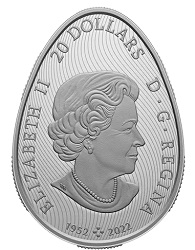
Face value: 20 dollars … Composition: 99.99% pure silver
with colour; Mintage: 7,500; Finish: Proof; Weight: 31.82 g;
Diameter: 45 mm x 33 mm; Edge: Interrupted serrations; Artist:
Natalie Kit (reverse), Susanna Blunt (obverse).
Packaging: Black clamshell with black beauty box.
DID YOU KNOW? … *** Trypillian pysanky are a modern expression of prehistoric designs: the symbols and colours are all grounded in traditions stemming from the ancient Trypillian civilization that existed in Ukraine between 5500 and 2750 BCE. *** Surviving pottery from this neolithic period—specifically, Trypillian urns that were once used to store the land’s bounty—served as inspiration for this pysanka design, and this is why Trypillian pysanky mostly feature black, reddish clay, brown and ochre colours.
Designed by artist Natalie Kit, your colourful fine silver pysanka features a Trypillian art style inspired by surviving neolithic pottery. Flanked by four parallel lines of life, the centre band features solar symbols and a weaving pattern containing seeds that represent the harvest. Another weaving pattern representing connection and continuity fills the upper and lower bands, where the grain is nurtured by rainfall. Above and below those bands, more lines of life bring strength and frame the powerful eternity line. The ripening grain is contained by vertical lines representing the four seasons, which are guided by time, represented by the spiral forms. The obverse features the effigy of Queen Elizabeth II by Susanna Blunt. The obverse also bears a special marking that includes four pearls symbolizing the four effigies that have graced Canadian coins and the double date of her reign.
Natalie Kit, Artist … My design reflects the infinite flow of time, with the river of life circling around and returning back in continuous harmony; the life-giving sky of light and rain; the bountiful earth producing the gift of food under the care of the people; and, during the seasonal death of winter’s sleep, the gathered and protected gifts of life, which are brought forth again in spring. To this day, the ancient symbols of harmony, fruitfulness, protection and life remain important and powerful symbols of the Ukrainian culture and people.
Janet C. Prebushewsky Danyliuk, Former Director and CEO, Ukrainian Museum of Canada … The design and imagery of the silver pysanka coin for 2023 pays homage to the unbreakable and undeniable tie to Mother Earth that the art of writing pysanky has depicted and honoured in its timeless tradition and history. This is the legacy of the Trypillian culture found thousands of years ago on present day Ukrainian land. The Royal Canadian Mint recognizes and honours this legacy with the release of this masterpiece of design and tradition.
Alicia Cook Sapene, Product Manager … Our hope was to bring to life the Trypillian motifs that are indicative of natural ties between the earth and the sun, and we wanted to maintain the illusion of the egg’s natural curvature while mimicking an antique style using earthy tones. The natural shine of silver incorporated into the intricate pattern is intended to brighten your collection!


2023 … O Canada Five-Coin Gift Card Set
www.mint.ca www.canadapost.ca
Celebrate Canada with this fun and memorable 5-coin set. The set features a unique $1 coin designed exclusively for this very special occasion! It also includes 2023 dated $2, 25¢, 10¢ and 5¢ coins with traditional designs. Artist: Steve Hepburn (Dollar); Mintage: 100,000; Finish: Uncirculated; Composition: Three-ply brass plated steel; Diameter: 26.5 mm; Weight 6.27 g.
Looking for a fun souvenir, an iconic Canadian gift, or an expression of love for this country? The O Canada Gift Card Set makes it easy to hold onto your memories of Canada in 2023. Inside the easy-to-mail, easy-to-display card are five 2023-dated Canadian non-circulation coins that offer a window into Canada’s character and natural heritage. One of those coins is an exclusive, special-themed $1 coin that combines two great Canadian icons—the moose and the maple leaf—on its reverse, where the proud pairing embodies Canada’s wild spirit and spaces.
As we focus our attention on commemorating the reign of Queen Elizabeth II (1952-2022), the Mint will not be issuing any 2023-dated Canadian circulation coins featuring both the traditional reverse designs and an obverse featuring Queen Elizabeth II. Instead, we are offering a collector’s edition of these annual issues that have been struck in limited numbers. These are non-circulation coins, meaning they are legal tender but not intended for general circulation. The obverse also bears a special marking that includes four pearls symbolizing the four effigies that have graced Canadian coins and the double date of her reign.

A set exclusive … Instead of a classic Loonie, the $1 coin in this set features the moose and the maple leaf—a proudly Canadian pairing! The playfully patriotic coin is a set exclusive—it was specially struck for the 2023 O Canada Gift Set and is not available on its own. Special obverse … The obverse of the five non-circulation coins features a marking that includes four pearls symbolizing the four effigies of Queen Elizabeth II that have graced Canadian coins and the double date of her II reign. Made for sharing … Perfect for in-person gift-giving, sharing, or even sending abroad. Need to mail it? A custom-designed envelope is enclosed for your convenience.
DID YOU KNOW? … *** Family portrait time! This set features two members of the deer family, each on a different coin. The moose ($1) is the largest member of the family, and it’s a lot bigger than the caribou (seen on the 25-cent non-circulation coin): a bull (male) moose can weigh 400-600 kilograms, while the caribou weighs up to 180 kilograms. *** A forest-dwelling herbivore, the moose eats a variety of plants and foliage (even maple leaves) throughout the warmer months, and mostly twigs, tree bark and shrubs during the winter.
The O Canada Gift Card Set’s exclusive $1 non-circulation coin features a reverse design by Canadian artist Steve Hepburn. A playfully patriotic representation of Canada, the design depicts a moose surrounded by maple leaves—including the national flag’s stylized maple leaf, which appears on the banner strung across the moose’s antlers. The obverse features the effigy of Queen Elizabeth II by Susanna Blunt. The obverse also bears a special marking that includes four pearls symbolizing the four effigies that have graced Canadian coins during her reign and the double date of her reign.

2023 … Silver Proof Dollar –
Kathleen “Kit” Coleman: Pioneer Journalist
www.mint.ca www.canadapost.ca
Pencil to paper to metal: The journey of journalism pioneer Kit Coleman is honoured on the 2023 Proof Dollar. Who was “Kit”? That’s what readers of the Toronto Daily Mail (later The Mail and Empire) were asking, as they pored over the writings of Kathleen Blake Coleman. An intrepid reporter with a lively journalistic voice, “Kit” Coleman rose above the fray in the male-dominated newspaper industry, tackling a wide range of issues as well as the topics typically covered in women’s columns. She made history 125 years ago by becoming North America’s first accredited woman war correspondent. Coleman also helped establish the Canadian Women’s Press Club in 1904 and served as its first president, and later became Canada’s first syndicated woman columnist.
In a time when women journalists were limited to writing about the female perspective and women’s issues, Kathleen Blake Coleman paved the way for better representation in newsrooms and a more equal standing for Canadian women in other aspects of life. A design within a design … The silhouette collage on your coin’s reverse captures key moments in the journalist’s life—from the office of the Toronto newspapers that published her columns from 1889 to 1911, to the vintage typewriter that represents her legacy and impact on journalism. An outstanding sculpt … Your Fine Silver Proof Dollar’s collage-within-a-silhouette design is incredibly detailed, and all those finely engraved elements are enhanced by a mix of frostings that help make each image distinct from the other.

Face value: 1 dollar … Composition: 99.99% pure silver;
Mintage: 35,000; Finish: Proof; Weight: 23.17 g;
Diameter: 36 mm; Edge: serrated; Artist: Pandora Young
(reverse), Susanna Blunt (obverse). Packaging:
Black clamshell with black beauty box.
DID YOU KNOW? … *** She was born Catherine Ferguson in 1856, in County Galway, Ireland, but identified herself privately as Kathleen Willis when she first came to Canada in 1884.She adopted the middle name Blake and by the time she began publishing, she was formally known as Kathleen Blake Watkins, and as Kathleen Blake Coleman when she later remarried.
*** Her pen name “Kit” and her public persona had readers guessing both her identity and gender. In her column, Coleman covered a wide range of topics in an attempt to break free from gender-based restrictions imposed upon the few presswomen of that era.
*** Kit first joined the Toronto Daily Mail as a women’s editor in 1889 in order to support herself and her two young children. Her weekly, seven-column “Woman’s Kingdom” page featured a mix of observations and advice, thought-provoking articles and travel writings. Coleman was known to go undercover in other cities, such as London and San Francisco, in order to write about social issues and the plight of the poor. Though her travel writings were curtailed after the Mail merged with the Empire in 1895, Kit was dispatched to London in 1897 to cover Queen Victoria’s Diamond Jubilee; while there, she spent time with Sir Wilfrid Laurier, then the prime minister of Canada (and reportedly an avid reader of Coleman’s column).
*** In 1898, during the Spanish-American War, Coleman became North America’s first accredited woman war correspondent. While she was authorized to accompany American troops in Cuba, her male colleagues and the army commanders on the ground were opposed to the idea of having a woman in their midst, and they prevented her travel. Stranded in Florida, she eventually landed in Cuba in July 1898; while she had missed the main battles, her accounts of the war’s aftermath made her internationally famous.
Designed by Canadian artist Pandora Young, your coin’s reverse features a silhouette of journalist Kathleen “Kit” Blake Coleman (1856-1915) holding an open notebook and pen. Within that silhouette are various elements that represent her life and career (from top to bottom): The Mail and Empire building in Toronto, Ont.; SS Circassian, the passenger ship that brought the Irish-born writer to Canada in 1884; a partial map of the Atlantic Ocean, to represent Coleman’s travels and dispatches; a view of Coleman writing at her desk; and a vintage typewriter that symbolizes her legacy and impact on Canadian journalism. The obverse features the effigy of Queen Elizabeth II by Susanna Blunt. The obverse also bears a special marking that includes four pearls symbolizing the four effigies that have graced Canadian coins and the double date of her reign.
Pandora Young, Artist … The biggest challenge was conveying the sheer scope of “Kit” Coleman’s accomplishments. She was intrepid, undaunted and a creative thinker, and those qualities took her on many wide-ranging adventures. Each time it seemed as if she was backed into a corner, she’d think up some ingenious new plan that only made her story more exciting. She elevated thought and discourse, as well as the voices and status of women—this is surely her most immortal legacy, and it is my hope that we can inspire collectors everywhere to learn more about Kathleen Blake Coleman.
Dr. Barbara Freeman, Author of Kit’s Kingdom: The Journalism of Kathleen Blake Coleman … Kathleen Blake Coleman, or Kit as she was known to her readers, was a pioneer female journalist in Canada, whose story is told on this well-deserved commemorative coin. She was an Irish immigrant to this country, struggled with single motherhood, and supported her children by producing an eclectic, interesting, and lively women’s page in Toronto’s Daily Mail, which later became the Mail and Empire. She loved to travel and write about her adventures and in 1898, her newspaper sent her to Cuba to cover the Spanish American War, a ground breaking assignment that won her international fame.

2023 … Pure Gold Coin –
Kathleen “Kit” Coleman: Pioneer Journalist
www.mint.ca www.canadapost.ca
Through her weekly columns, journalist Kathleen Blake Coleman (1856-1915) pushed the boundaries of expectation for women in journalism during the late 19TH and early 20TH centuries. “Kit” was a woman of many firsts: she made history 125 years ago by becoming North America’s first accredited woman war correspondent; she helped establish the Canadian Women’s Press Club and served as its first president; and later, she became the first syndicated woman columnist in Canada. A pioneer deserving of her place on the 2023 Proof Dollar, Kit Coleman is also honoured on this 99.99% pure gold coin, which pairs a portrait of the trailblazing columnist with a map that traces her incredible journey. A pure gold homage to a journalism pioneer.
Richly detailed … Crafted in 99.99% pure gold, your coin’s reverse features an outstanding amount of finely engraved details, and it captures both the likeness and legacy of Kit Coleman. Pencil to paper to precious metal… The Toronto-based journalist is shown penning her weekly newspaper column, while behind her, the map traces her incredible journey—from her birthplace in Ireland to her life and career in Canada, and her many travels abroad.

Face value: 100 dollars … Composition: 99.99% pure gold;
Mintage: 1,500; Finish: Proof; Weight: 7.8g;
Diameter: 20 mm; Edge: serrated; Artist: Pandora Young
(reverse), Susanna Blunt (obverse); Packaging:
Maroon clamshell with black beauty box.
DID YOU KNOW? … *** She was born Catherine Ferguson in 1856, in County Galway, Ireland, but identified herself privately as Kathleen Willis when she first came to Canada in 1884. She adopted the middle name Blake and by the time she began publishing, she was formally known as Kathleen Blake Watkins, and as Kathleen Blake Coleman when she later remarried.
*** Her pen name “Kit” and her public persona had readers guessing both her identity and gender. In her column, Coleman covered a wide range of topics in an attempt to break free from gender-based restrictions imposed upon the few presswomen of that era.
*** Kit first joined the Toronto Daily Mailas a women’s editor in 1889 in order to support herself and her two young children. Her weekly, seven-column “Woman’s Kingdom” page featured a mix of observations and advice, thought-provoking articles and travel writings. Coleman was known to go undercover in other cities, such as London and San Francisco, in order to write about social issues and the plight of the poor. Though her travel writings were curtailed after the Mail merged with the Empire in 1895, Kit was dispatched to London in 1897 to cover Queen Victoria’s Diamond Jubilee; while there, she spent time with Sir Wilfrid Laurier, then the prime minister of Canada (and reportedly an avid reader of Coleman’s column).
*** In 1898, during the Spanish-American War, Coleman became North America’s first accredited woman war correspondent. While she was authorized to accompany American troops in Cuba, her male colleagues and the army commanders on the ground were opposed to the idea of having a woman in their midst, and they prevented her travel. Stranded in Florida, she eventually landed in Cuba in July 1898; while she had missed the main battles, her accounts of the war’s aftermath made her internationally famous.
Designed by Canadian artist Pandora Young, your coin’s reverse features a portrait of Toronto-based journalist Kathleen “Kit” Blake Coleman (1856-1915) penning her weekly column. The map in the background traces the trailblazing reporter’s incredible journey—from her birthplace in Ireland to her life and career in Canada, and her travels as North America’s first accredited woman war correspondent. The obverse features the effigy of Queen Elizabeth II by Susanna Blunt. The obverse also bears a special marking that includes four pearls symbolizing the four effigies that have graced Canadian coins and the double date of her reign.
Pandora Young, Artist … The biggest challenge was conveying the sheer scope of “Kit” Coleman’s accomplishments. She was intrepid, undaunted and a creative thinker, and those qualities took her on many wide-ranging adventures. Each time it seemed as if she was backed into a corner, she’d think up some ingenious new plan that only made her story more exciting. She elevated thought and discourse, as well as the voices and status of women—this is surely her most immortal legacy, and it is my hope that we can inspire collectors everywhere to learn more about Kathleen Blake Coleman.
Dr. Barbara Freeman, Author of Kit’s Kingdom: The Journalism of Kathleen Blake Coleman … Kathleen Blake Coleman, or Kit as she was known to her readers, was a pioneer female journalist in Canada, whose story is told on this well-deserved commemorative coin. She was an Irish immigrant to this country, struggled with single motherhood, and supported her children by producing an eclectic, interesting, and lively women’s page in Toronto’s Daily Mail, which later became the Mail and Empire. She loved to travel and write about her adventures and in 1898, her newspaper sent her to Cuba to cover the Spanish American War, a ground breaking assignment that won her international fame.

2022 Special Edition Proof Silver Dollar
– The Imperial State Crown
www.mint.ca www.canadapost.ca
“The Crown represents the basic political ideals which all Canadians share. It stands for the idea that individual people matter more than theories; that we are all subject to the rule of law. These ideals are guaranteed by a common loyalty, through the Sovereign, to community and country.” – Queen Elizabeth II Crafted in 99.99% pure silver, this selectively gold-plated dollar features a design that pays homage to Queen Elizabeth II; to her decades-long reign; and to her unwavering commitment to her role as the embodiment of the Crown.
Pure silver … This coin has been expertly crafted in 99.99% pure silver with a proof finish that emphasizes the engraving. Tribute obverse … Marked by a small Tudor rose, the tribute obverse combines the four different effigies that have graced Canadian coins since 1953. The obverse is only featured on the numismatic coins that are part of the Queen Elizabeth II’s Reign collection.
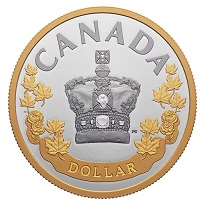
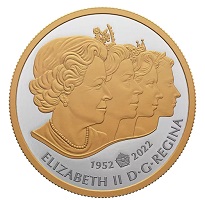
Face value: 1 dollar … Composition: 99.99% pure silver
with selective gold plating; Mintage: 15,000; Finish: Proof;
Weight: 23.17 g; Diameter: 36.07 mm; Edge: serrated;
Artist: Francois Guitard (reverse), Susanna Blunt
(2003-2022), Dora de Pédery-Hunt (1990-2002 effigy),
Arnold Machin (1965-1989 effigy) and Mary Gillick
(1953-1964 effigy) (obverse); Packaging:
Clamshell with special graphic beauty box.
DID YOU KNOW? … While St. Edward’s Crown is only ever used for the coronation, the Imperial State Crown (or Crown of State) is worn on formal occasions, such as the State Opening of (British) Parliament. The State Crown has been replaced 10 times since the Restoration in 1660. The one depicted on this coin was made for the coronation of King George VI in 1937; it is a replica of the crown designed for Queen Elizabeth II’s great-great-grandmother, Queen Victoria, in 1838.
Enhanced with gold plating, the reverse design by Canadian artist Francois Guitard features the Imperial State Crown framed by maple leaves and roses that represent the reign of Queen Elizabeth II. A Queen Elizabeth rose and a maple leaf also appear at the edges of a banner that bears the face value, “DOLLAR”, while “CANADA” is inscribed at the top.
Double dated to commemorate the historic reign of Queen Elizabeth II, the tribute obverse is marked by a Tudor rose and features the four effigies that have appeared on Canadian coins since 1953 (left to right): the 2003-2022 effigy by Susanna Blunt; the 1990-2002 effigy by Dora de Pédery-Hunt; the 1965-1989 effigy by Arnold Machin; and the 1953-1964 effigy by Mary Gillick.

2022 … $20 Pure Silver Coin –
The Imperial State Crown
www.mint.ca www.canadapost.ca
A symbol of Queen Elizabeth II and her extraordinary reign, the Royal Cypher on the coin’s reverse is framed by an artistic interpretation of the Imperial State Crown, complete with colourful glass stones and four crystals that tie into your coin’s obverse. The Imperial State Crown is one of the most iconic pieces of royal regalia known as the Crown Jewels. This was the crown worn by Queen Elizabeth II upon leaving Westminster Abbey after her coronation in 1953; and in the many years that followed, it was the one that represented both her authority as Head of State and the grace with which she reigned.
Glass stones … On your coin’s reverse, the artistic interpretation of the Imperial State Crown is enhanced with 16 blue and green glass stones that add colour. They also represent some of the historic jewels that famously adorn the crown, as well as those from Queen Elizabeth II’s jewellery collection. Crystals … The reverse also features four crystals—one for each of the effigies that have graced Canada’s circulation coins since 1953. The symbol of a reign … Included on the coin’s reverse, Queen Elizabeth II’s personal identifier, the Royal Cypher, served as a symbol of Canada’s sovereignty and its sovereign for 70 years.
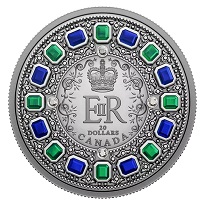

Face value: 20 dollars … Composition: 99.99% pure silver
with eight blue glass stones, eight green glass stones and
four crystals; Mintage: 8,000; Finish: Matte Proof;
Weight: 31.39 g; Diameter: 38 mm; Edge: serrated;
Artist: RCM engraver Cecily Mok (reverse), Susanna Blunt
(2003-2022), Dora de Pédery-Hunt (1990-2002 effigy),
Arnold Machin (1965-1989 effigy) and Mary Gillick
(1953-1964 effigy) (obverse); Packaging:
Black clamshell with commemorative beauty box.
DID YOU KNOW? … *** While St. Edward’s Crown is only ever used for the coronation, the Imperial State Crown (or Crown of State) is worn on formal occasions, such as the State Opening of (British) Parliament. *** The State Crown has been replaced 10 times since the Restoration in 1660. The one depicted on this coin was made for the coronation of Queen Elizabeth II’s father, King George VI, in 1937; it is a replica of the crown designed for Queen Elizabeth II’s great-great-grandmother, Queen Victoria, in 1838.
Your coin’s reverse features the Royal Cypher of Queen Elizabeth II surrounded by an artistic representation of the Imperial State Crown, as viewed from above. An arrangement of 8 blue and 8 green glass stones stand in for the array of precious stones that adorn the crown, while the reverse includes four crystals—one for each of the effigies that have graced Canada’s coins since 1953. Double dated to commemorate Queen Elizabeth II’s historic reign, the tribute obverse is marked by a Tudor rose and features the four historic effigies of Queen Elizabeth II (left to right): the 2003-2022 effigy by Susanna Blunt; the 1990-2002 effigy by Dora de Pédery-Hunt; the 1965-1989 effigy by Arnold Machin; and the 1953-1964 effigy by Mary Gillick.

2022 … $5 Pure Silver Coin –
Remembering Queen Elizabeth II
www.mint.ca www.canadapost.ca
During her long reign, Queen Elizabeth II made 22 official visits to Canada, more times than to any other Commonwealth nation. These travels brought The Queen to every province and territory, where, reunited with her Canadian “family,” she joined in some of our greatest celebrations and milestones.
This fine silver coin commemorates the legacy of Queen Elizabeth II. Surrounded by engraved maple leaves, the coin’s reverse features the colour portrait that was taken during her last Canadian homecoming in 2010. The reverse design features a cropped version of the official Canadian portrait of Queen Elizabeth II, who is seen wearing her Canadian insignia as Sovereign of the Order of Canada and the Order of Military Merit. The photograph was taken on July 1, 2010, at Rideau Hall, home of The Queen’s representative in Canada. The colour portrait is paired with the Royal Cypher and surrounded by engraved maple leaves representing Canada. Double-dated to commemorate Queen Elizabeth II’s historic reign, the tribute obverse is marked by a Tudor rose and features the four effigies of Queen Elizabeth II that have appeared on Canadian coins since 1953 (left to right): the 2003-2022 effigy by Susanna Blunt; the 1990-2002 effigy by Dora de Pédery-Hunt; the 1965-1989 effigy by Arnold Machin; and the 1953-1964 effigy by Mary Gillick.
During her long reign, Queen Elizabeth II made 22 official visits to Canada, more times than to any other Commonwealth nation. These travels brought The Queen to every province and territory, where, reunited with her Canadian “family,” she joined in some of our greatest celebrations and milestones. This fine silver coin commemorates the legacy of Queen Elizabeth II. Surrounded by engraved maple leaves, the coin’s reverse features the colour portrait that was taken during her last Canadian homecoming in 2010.
Colour over engraving … The portrait is re-created using a combination of engraving and paint. Tribute obverse … Marked by a small Tudor rose, the tribute obverse combines the four different effigies that have graced Canadian coins since Queen Elizabeth II’s coronation in 1953. This obverse is only featured on the numismatic coins in the Queen Elizabeth II’s Reign collection.
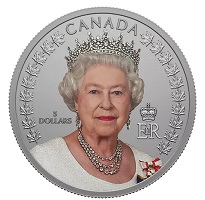
Face value: 5 dollars … Composition: 99.99% pure silver;
Mintage: While supplies last; Finish: Matte Proof;
Weight: 7.96 g; Diameter: 27 mm; Edge: serrated;
Artist: Francois Guitard (reverse), Susanna Blunt (2003-2022),
Dora de Pédery-Hunt (1990-2002 effigy), Arnold Machin
(1965-1989 effigy) and Mary Gillick (1953-1964 effigy) (obverse).
Packaging: Gift card packaging.
DID YOU KNOW? … In this official Canadian portrait, Queen Elizabeth II is shown wearing her Canadian insignia as Sovereign of the Order of Canada and the Order of Military Merit. The Canadian monarch is the “fount of all honour,” the sole person who may grant decorations, medals or an investiture into an order—Canadian honours are presented by the Governor General on behalf of the Sovereign.
The reverse design features a cropped version of the official Canadian portrait of Queen Elizabeth II, who is seen wearing her Canadian insignia as Sovereign of the Order of Canada and the Order of Military Merit. The photograph was taken on July 1, 2010, at Rideau Hall, home of The Queen’s representative in Canada. The colour portrait is paired with the Royal Cypher and surrounded by engraved maple leaves representing Canada. Double-dated to commemorate Queen Elizabeth II’s historic reign, the tribute obverse is marked by a Tudor rose and features the four effigies of Queen Elizabeth II that have appeared on Canadian coins since 1953 (left to right): the 2003-2022 effigy by Susanna Blunt; the 1990-2002 effigy by Dora de Pédery-Hunt; the 1965-1989 effigy by Arnold Machin; and the 1953-1964 effigy by Mary Gillick.

2022 … $20 Fine Silver 3-Coin Set –
A Tribute to an Extraordinary Life
www.mint.ca www.canadapost.ca
Queen Elizabeth II was born a princess, but wasn’t destined to reign until fate intervened. Suddenly the heiress presumptive at the age of 10, a young Princess Elizabeth accepted her destiny with grace, putting a lifelong sense of duty and a deep love of her country and the Commonwealth above all else. This fine silver set is a three-part, photo-inspired celebration of an extraordinary life and reign. Packaged in an informative presentation folder, each coin commemorates a different chapter in the life story of Queen Elizabeth II, from princess to long-reigning queen. And together as one set, these coins will forever preserve the legacy of the beloved Queen of Canada.
A celebration of life … Our three-coin A Tribute to an Extraordinary Life series is a celebration of an extraordinary life. Each coin is inspired by a famous photograph and represents a different chapter in the life story of Queen Elizabeth II, from princess to long-reigning monarch. Tribute obverse … Marked by a small Tudor rose, the tribute obverse combines the four different effigies that have graced Canadian coins since Queen Elizabeth II’s coronation in 1953. This homage obverse is only featured on the numismatic coin in the Queen Elizabeth II’s Reign.
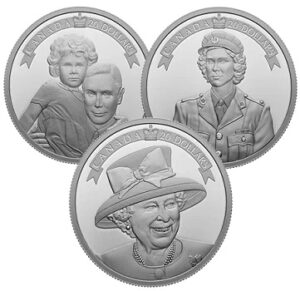
Face value: 20 dollars … Composition: 99.99% pure silver;
Mintage: 7,500; Finish: Proof; Weight: 31.39 g;
Diameter: 38 mm; Edge: serrated;
Artist: Susanna Blunt; Dora de Pédery-Hunt;
Arnold Machin; and Mary Gillick (obverse);
Packaging: Packaged in commemorative folder.
DID YOU KNOW? … *** Queen Elizabeth II was named after her mother, Queen Elizabeth The Queen Mother, while her two middle names honour her great-grandmother, Queen Alexandra, and her grandmother, Queen Mary. *** Queen Elizabeth II was the first monarch to be proclaimed Sovereign of Canada upon her accession to the throne.
Coin #1 – Childhood … The reverse design is based on a 1929 photograph of Queen Elizabeth II, then a young Princess Elizabeth, with her father, the future King George VI.
Coin #2 – Princess in the Military … The reverse design by Canadian artist Neil Hamelin features Princess Elizabeth during the Second World War as she joined the Women’s Auxiliary Territorial Service.
Coin #3 – Royal Visit … The reverse design is based on a photograph of Queen Elizabeth II in Halifax, N.S., during the Canadian Navy Centennial celebration held on June 29, 2010.
On all three coins: Double dated to commemorate Queen Elizabeth II’s historic reign, the tribute obverse is marked by a Tudor rose and features the four effigies of Queen Elizabeth II that have appeared on Canadian coins since 1953 (left to right): the 2003-2022 effigy by Susanna Blunt; the 1990-2002 effigy by Dora de Pédery-Hunt; the 1965-1989 effigy by Arnold Machin; and the 1953-1964 effigy by Mary Gillick.


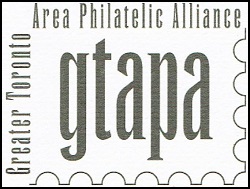
www.gtapa.org
The GTAPA is committed to promote and stimulate
the art of philately to all ages for fun,
culture, education, and friendship.




